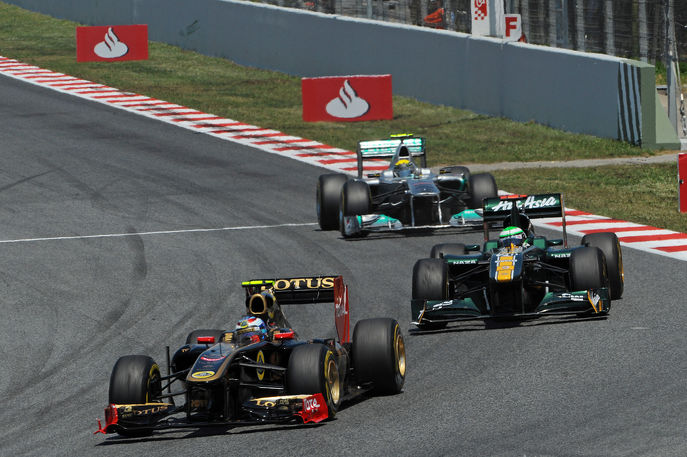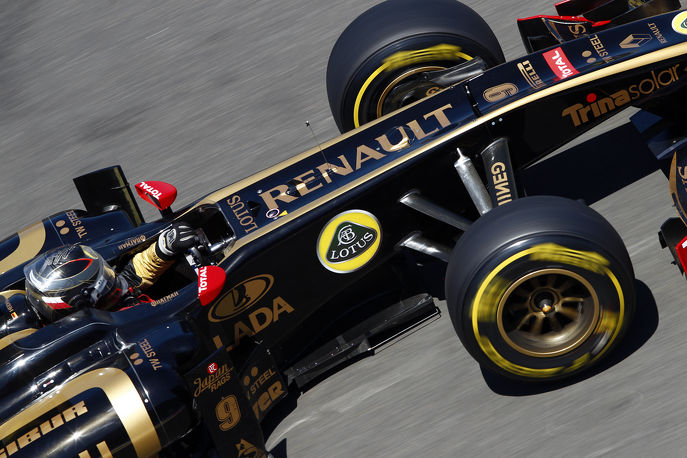Renault Sport F1 Preview to the British GP

This weekend the FIA Formula One World Championship makes its annual visit to Silverstone, Great Britain. Well attended by fans and media, it's also a special event for Renault Sport F1's partner teams, who are based within two hours' drive of the Northamptonshire-based track. Red Bull Racing is located in Milton Keynes, some 30km away, Lotus Renault GP in the neighbouring county and Team Lotus slightly further afield to the east of England in Norfolk. New-for-2012 partner AT&T Williams is also based to the south of Oxford.
Renault Sport F1 has reasons of its own to look forward to the race as it's been the scene of some of its finest-ever victories. The first win came in 1983 with the Renault RE40 and Alain Prost, with Nigel Mansell taking the winners' spoils in 1991 for Williams-Renault. This win started a series of wins for Renault engines at Silverstone: alongside partners Williams and Benetton, the V10 took seven consecutive victories from 1991 to 1997. Fernando Alonso also won in 2006 for the Renault F1 Team and current partners Red Bull Racing finished on the top step in 2009 and 2010.

A lap of Silverstone from an engine point of view
From its first configuration as part of a WWII airfield, Silverstone has historically been a ‘power track'. The circuit has since undergone numerous re-incarnations but has retained its high-speed character. In fact, it was at Silverstone in 1985 that the fastest ever qualifying lap was recorded when Keke Rosberg set an average speed of more than 250kph over one lap, a record that stood for 16 years. Last year there were further track modifications with the addition of a new complex between the Abbey and Luffield corners but the track remains one of the quickest tracks of the season, with approximately 65% of the lap spent at full throttle with a high average speed.

Sector one
The start-finish line has been moved this year to the international pit straight that starts after Club Corner following the recent completion of the new pits and paddock complex with its impressive jagged-edge roof. The first corner is now the super quick Abbey corner, a right hand flick taken at 265kph. The first heavy braking zone comes at turn 3, or Village, taken in second gear at 95kph. It's the start of a slow complex where engine driveability is key. After rounding turn five, cars then blast onto the Wellington straight: top speed at the end of the straight will be around 300kph.

Sector two
Sector two starts before the Brooklands corner, the start of another low speed section that sees cars brake down from 300kph to third gear and 140kph and then shift down again for the Luffield turns, a spoon-profiled corner taken in second at around 100kph. After this it's then back on the throttle down the old pit straight, shifting into seventh gear and hitting 302kph before shifting down to sixth for Copse corner. Despite the tight profile of this corner, it's still taken at around 260kph so lateral g-forces are very high. After a short sprint comes the awesome Maggotts-Beckett-Chapel complex, a sweeping, high-speed complex of four connecting bends that need rapid changes of direction and complete responsiveness from the engine. Average speeds through this section are around 250kph and speeds will be no lower than 190kph at any one point.

Sector three
After the complex the cars then blast down the Hangar Straight, the longest straight on the circuit at 875m. Top speeds here will peak at 310kph before the braking zone for the first corner in this sector, Stowe, a fourth gear right hander. Then it's onto the Vale straight and then a quick left hand chicane and the radial turn of Club, taken in second gear.

View from Rémi Taffin, head of Renault Sport F1 track operations
Silverstone is always a great event for Renault Sport F1 since our current partners are based in the UK. Technically there isn't any more effort for this race, but the fact there are so many people from partners' factories means we all want to put on a good show and achieve a good result on ‘home ground'.
Even with the changes last year, Silverstone is still a power track, with 66% of the lap spent at full throttle in qualifying and 61% in the race. With the four straights over the course of the lap the average speed is also high - approx 215kph - so it sits towards the top end of the calendar in terms of the demands it puts on the engine. At the same time the engine has to be responsive out of the slower corners such as Luffield and the Loop since they all lead onto the long straights.

Another challenge this weekend will be the introduction of a new technical directive issued by the FIA to limit the effect of off-throttle exhaust blowing devices. This obviously requires a lot of work from the teams in Viry before the race and over the weekend, pending the results of Friday practice. In terms of the results, we may find that it affects the balance of the car as they have been developed around different floor concepts based on the exhaust gas flow. It is possible that the noise could also be different. Pre-Valencia it almost sounded like the cars were running with traction control as there were a lot of braking sounds, but now engines will sound smoother.
This will also be our second race with the ban on changing engine maps between qualifying and the race. Our maps have always been very similar between qualifying and the race anyway, but should the weather be predicted to change between qualifying and the race we will have to think very carefully about which maps to use. Historically the weather can change quite a lot over the Silverstone weekend, so overall it's shaping up to be an interesting weekend.

Did you know...
A blown diffuser is where exhaust gases are directed from the exhaust outlet to the diffuser at the rear of the car. The use of the gases helps generate more downforce and therefore helps increase stability under braking and on the exit from corners. The problem with this is that when the driver is off the throttle there is no exhaust gas. A hot blown diffuser is used to maintain a constant stream of gas through the diffuser to maintain downforce levels. When a driver goes off the throttle pedal with a hot blown diffuser, the engine throttles are kept open, fuel keeps being injected and is ignited through careful mapping, therefore creating gas flow.
British Grand Prix facts and figures
2010 qualifying results
1. Sebastian Vettel Red Bull Racing Renault 1:29.615
2. Mark Webber Red Bull Racing Renault 1:29.758
3. Fernando Alonso Ferrari 1:30.426
4. Lewis Hamilton McLaren 1:30.556
5. Nico Rosberg Mercedes GP 1:30.625
6. Robert Kubica Renault F1 Team 1:31.040
7. Felipe Massa Ferrari 1:31.172
8. Rubens Barrichello Williams 1:31.175
9. Pedro de la Rosa Sauber 1:31.274
10. Michael Schumacher Mercedes 1:31.430
2010 results
1. Mark Webber Red Bull Racing Renault 1:24:38.200
2. Lewis Hamilton McLaren +1.3secs
3. Nico Rosberg Mercedes GP +21.3secs
4. Jenson Button McLaren +21.9secs
5. Rubens Barrichello Williams +31.4secs
6. Kamui Kobayashi Sauber +32.1secs
7. Sebastian Vettel Red Bull Racing Renault +36.7secs
8. Adrian Sutil Force India F1 Team +40.9secs
9. Michael Schumacher Mercedes GP +41.5secs
10. Nico Hulkenberg Williams +42.0secs
Diskusia k článku
Najnovšie galérie
































 Jari-Matti
Jari-Matti 
 Kristian
Kristian  Peter
Peter 
 Marcus
Marcus  Brice
Brice 